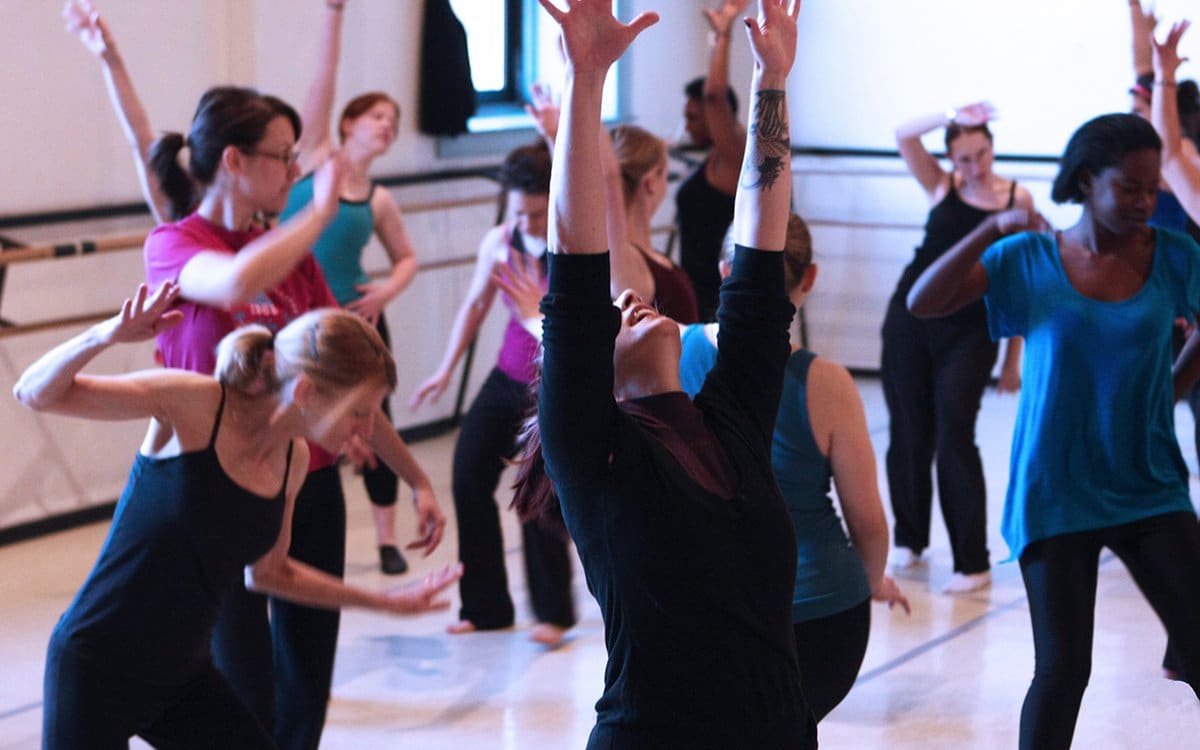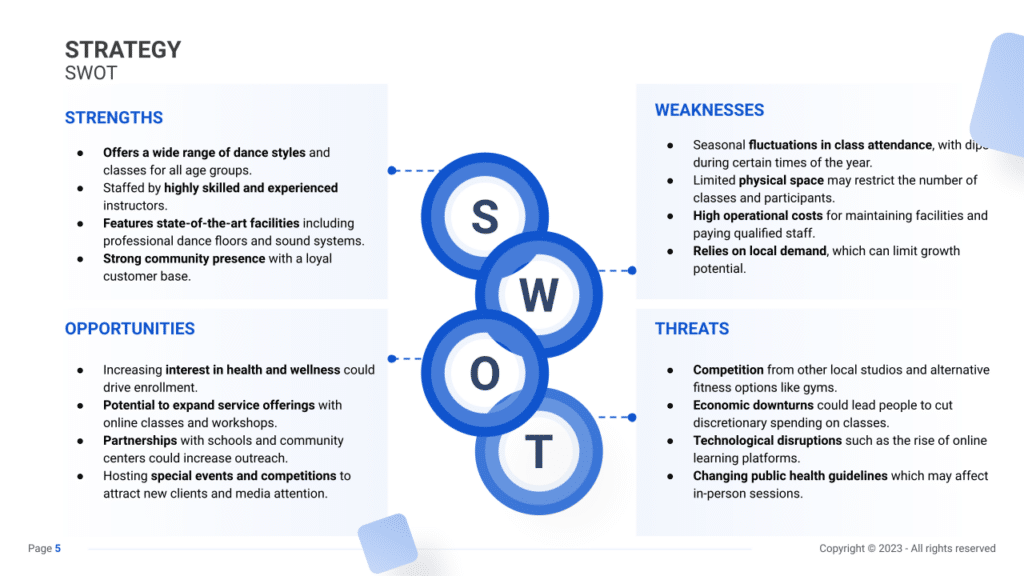SWOT Analysis for a Dance Studio: Template & Example

A SWOT analysis is crucial for developing a business plan for a dance studio. This analysis, which stands for Strengths, Weaknesses, Opportunities, and Threats, helps understand internal and external factors that can impact your business. Strengths and weaknesses are internal to the business, while opportunities and threats are external.
In this article, we will explore various examples of strengths, weaknesses, opportunities, and threats, aiding dance studio owners in refining their business strategies for success.

Strengths
Highlight the unique attributes that distinguish your dance studio, fostering a competitive advantage and student loyalty.
- Experienced and Qualified Instructors: The expertise and qualifications of your dance instructors in various styles, such as ballet, hip-hop, contemporary, etc., stand as a significant strength. Emphasize their proficiency and teaching credentials to attract aspiring dancers seeking quality instruction.
- Example: Promote instructors’ qualifications on the studio’s website and social media platforms, showcasing their achievements and expertise.
- Variety of Dance Styles and Classes: Offering a diverse range of dance styles and classes appeals to a broader audience. Providing options for various skill levels and interests strengthens the studio’s appeal and keeps students engaged.
- Example: Emphasize the variety of dance styles offered through promotional materials and trial classes to attract dancers with different preferences.
- Well-Equipped Dance Facilities: State-of-the-art dance studios equipped with quality sound systems, spacious mirrored rooms, and proper flooring elevate the overall dancing experience.
- Example: Showcase the studio’s facilities through virtual tours on the website or social media to attract potential students.
- Strong Community Engagement: Active involvement in local events, performances, and workshops fosters a sense of community and loyalty among students and their families.
- Example: Organize regular showcases or charity events involving students to showcase their progress and contribute to the community.
Weaknesses
Address shortcomings to reinforce and fortify your dance studio, paving the way for sustainable success and growth.
- Limited Marketing and Branding: Inadequate marketing efforts or a lack of a strong brand presence can limit visibility and hinder attracting new students.
- Example: Invest in online marketing strategies, collaborate with influencers, and revamp the studio’s brand identity to increase outreach.
- Seasonal Fluctuations in Enrollment: Inconsistent enrollment patterns due to seasonal variations can impact revenue and stability.
- Example: Introduce themed workshops or intensives during off-peak seasons to maintain student engagement throughout the year.
- Dependence on Local Demographics: Over-reliance on a specific demographic or location can pose challenges if demographic preferences shift or if the area faces economic downturns.
- Example: Diversify marketing strategies to attract students from neighboring communities or target niche demographics through tailored classes or events.
- Staffing Issues: Difficulty in retaining qualified instructors or administrative staff due to competition or turnover can affect the quality of classes and customer service.
- Example: Implement programs to incentivize staff retention, offer professional development opportunities, and create a positive work environment.
Opportunities
Seize prospects to innovate and expand the offerings of your dance studio, unlocking new avenues for growth and development.
- Online Dance Classes and Hybrid Learning: Leveraging online platforms to offer virtual classes allows access to a wider audience beyond geographical constraints.
- Example: Develop online tutorials, live-streamed classes, or a subscription-based platform to reach global audiences.
- Collaborations with Schools and Events: Partnering with schools for dance programs or collaborating with event planners for performances can increase visibility and attract potential students.
- Example: Organize workshops or performances at local schools and community events to showcase the studio’s talent and offerings.
- Specialized Dance Workshops and Masterclasses: Introducing specialized workshops or inviting renowned guest instructors for masterclasses can attract enthusiasts and serious dancers seeking higher-level training.
- Example: Promote exclusive workshops in niche dance styles or techniques to draw dedicated dancers seeking advanced training opportunities.
- Fitness and Wellness Integration: Integrating dance fitness programs or wellness initiatives into the studio’s offerings caters to health-conscious individuals seeking alternative workout routines.
- Example: Develop dance fitness classes or wellness workshops emphasizing physical and mental health benefits to attract a broader audience.
Threats
Prepare for potential challenges and threats to safeguard the resilience and continuity of your dance studio’s operations and success.
- Economic Instability: Economic downturns may lead to decreased discretionary spending, impacting enrollment and participation in dance classes.
- Example: Offer flexible payment plans or discounts during financially challenging periods to retain students.
- Competition from Other Studios and Fitness Centers: Intense competition from other dance studios or fitness centers offering dance-related activities can impact student retention.
- Example: Highlight the studio’s unique selling points and personalized approach to differentiate from competitors, focusing on the quality of instruction and community engagement.
- External Regulations and Licensing: Changes in regulations related to dance studio operations or safety standards can pose compliance challenges and incur additional costs.
- Example: Stay updated with local regulations, maintain safety standards, and acquire necessary certifications to ensure compliance.
- Technological Disruptions and Online Learning: Rapid advancements in online learning platforms or virtual reality experiences may pose a threat by providing alternative ways for individuals to learn dance without physical studios.
- Example: Embrace technology by offering high-quality virtual dance experiences complementing in-person classes, catering to diverse learning preferences.





